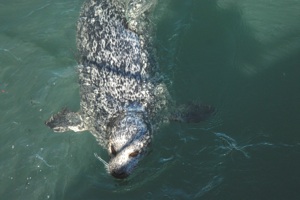Marine Mammal Species Description
Harbor Seal
Phoca vitulina

Photo credit: Dr. Mridula Srinivasan, NOAA/NMFS/OST/AMD
Classification
Order: Carnivora
Family: Phocidae
Alternate Common Names:
Status: protected under MMPA
Description:
Length: 5-6 feet (1.5-1.9 m)
Weight:
Harbor seals are small pinnipeds, and sexually dimorphic in size with adult males being larger than adult females. They have two sets of paired fins, large eyes, and no external ears. They have a brownish or grayish coat that is commonly mottled with sp
Habitat:
Harbor seals are most often seen at their resting sites, hauled out on rocks, beaches, ice, and man-made structures. When in the water they are most often seen in the bays, estuaries, and tidal areas but some have been seen far out to sea.
Feeding:
Harbor seals feed on a variety of food including fish, cephalopods, and crustaceans. In any given area they typically eat the most abundant food items. An average dive for harbor seals is 100-330 feet (30-100 m), with a recorded maximum close to 1640 feet (500 m). They can stay submerged for close to 30 minutes, but on average only stay submerged six minutes.
Reproduction:
Adult harbor seals reach sexual maturity at 3-5 years. The gestation period lasts approximately nine months after the fertilized egg is implanted. Implantation can be delayed up to two months. Harbor seals usually give birth to one pup once a year, but occasionally twins are born. In the Western Atlantic, pups are usually born from May-July on land or sometimes on floating icebergs. After birth pups are nursed from four to six weeks and can feed on their own a few weeks after they are born.
Other:
Life expectancy for harbor seals averages 25 years with maximum life span around 35 years. Females have a longer average life span than males. Adult harbor seals fall prey to a variety of predators including sharks, killer whales, sea lions, walruses, and polar bears. Pups are also taken by coyotes, eagles, and feral dogs. Harbor seals have also fallen victim to viral outbreaks and disease, including phocine distemper, which killed over 18,000 harbor seals in Europe in 1988.
Distribution / Range:
Harbor seals are widespread in the coastal areas of the Northern Hemisphere. In the United States, they occur primarily in the northern states in areas that are free of ice during their breeding season. Records of this species have occurred as far south as Florida. There are five recognized subspecies of harbor seals. Phoca vitulina concolor is the recognized subspecies that occurs in the Western Atlantic.
Similar species:
There are no seal species commonly found in the coastal waters of the southeastern United States.
Notes:
References:
Burns, J.J. 2009. Harbor Seal and Spotted Seal - Phoca vitulina and P. largha. In: Encyclopedia of Marine Mammals 2nd Ed. Perrin W.F., B. W�rsig, and J.G.M. Thewissen, eds. Academic Press, New York, pp. 533-542.
Reeves, R.R. 1999. Harbor seal, Phoca vitulina . In The Smithsonian Book of North American Mammals. Wilson, D.E. and S. Ruff, eds., 209-211. Smithsonian Institution in association with the American Society of Mammologists, Washington DC.
Thompson, D. & H�rk�nen, T. 2008. Phoca vitulina. In: IUCN 2011. IUCN Red List of Threatened Species. Version 2011.2. www.iucnredlist.org. Downloaded on 09 January 2012.

 Marine Mammals of Georgia
Marine Mammals of Georgia